Analysis of Obesity Prevention Programs: OPAL, PEACH, and HVP
VerifiedAdded on 2022/09/12
|10
|1979
|24
Essay
AI Summary
This essay provides an overview of obesity prevention programs in Australia, focusing on three key strategies: OPAL, PEACH, and Home Visitors Program (HVP). The OPAL program, implemented in South Australia, aims to reduce childhood obesity through behavioral changes, emphasizing healthy eating habits and local food accessibility. The PEACH program, or Parenting, Eating and Activity for Child Health, is a family-focused intervention targeting overweight and obese children through group meetings and lifestyle modifications. The HVP program focuses on preventing obesity among infants and mothers through nutritional interventions, physical activity, and behavioral strategies, often targeting low-income families. The essay discusses the effectiveness, approaches, and inclusive practices of each program, highlighting their roles in improving health outcomes and addressing the growing concern of obesity in Australia. The essay concludes with a summary of the strengths and weaknesses of each program and their contribution to improving the quality of life of the children.

Running head: OBESITY PREVENTION PROGRAMS
Obesity Prevention Programs
Name of the Student
Name of the University
Author Note
Obesity Prevention Programs
Name of the Student
Name of the University
Author Note
Paraphrase This Document
Need a fresh take? Get an instant paraphrase of this document with our AI Paraphraser
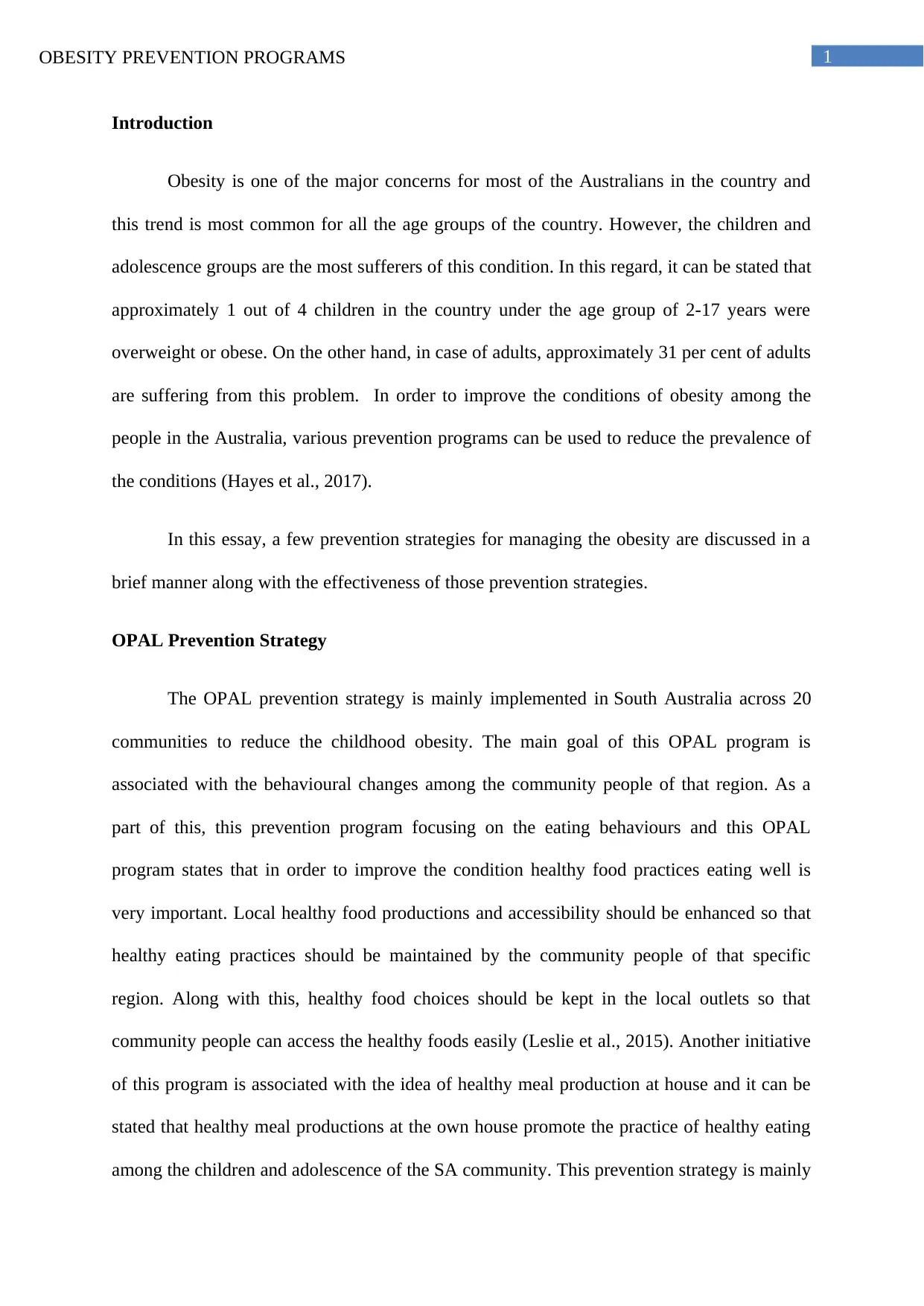
1OBESITY PREVENTION PROGRAMS
Introduction
Obesity is one of the major concerns for most of the Australians in the country and
this trend is most common for all the age groups of the country. However, the children and
adolescence groups are the most sufferers of this condition. In this regard, it can be stated that
approximately 1 out of 4 children in the country under the age group of 2-17 years were
overweight or obese. On the other hand, in case of adults, approximately 31 per cent of adults
are suffering from this problem. In order to improve the conditions of obesity among the
people in the Australia, various prevention programs can be used to reduce the prevalence of
the conditions (Hayes et al., 2017).
In this essay, a few prevention strategies for managing the obesity are discussed in a
brief manner along with the effectiveness of those prevention strategies.
OPAL Prevention Strategy
The OPAL prevention strategy is mainly implemented in South Australia across 20
communities to reduce the childhood obesity. The main goal of this OPAL program is
associated with the behavioural changes among the community people of that region. As a
part of this, this prevention program focusing on the eating behaviours and this OPAL
program states that in order to improve the condition healthy food practices eating well is
very important. Local healthy food productions and accessibility should be enhanced so that
healthy eating practices should be maintained by the community people of that specific
region. Along with this, healthy food choices should be kept in the local outlets so that
community people can access the healthy foods easily (Leslie et al., 2015). Another initiative
of this program is associated with the idea of healthy meal production at house and it can be
stated that healthy meal productions at the own house promote the practice of healthy eating
among the children and adolescence of the SA community. This prevention strategy is mainly
Introduction
Obesity is one of the major concerns for most of the Australians in the country and
this trend is most common for all the age groups of the country. However, the children and
adolescence groups are the most sufferers of this condition. In this regard, it can be stated that
approximately 1 out of 4 children in the country under the age group of 2-17 years were
overweight or obese. On the other hand, in case of adults, approximately 31 per cent of adults
are suffering from this problem. In order to improve the conditions of obesity among the
people in the Australia, various prevention programs can be used to reduce the prevalence of
the conditions (Hayes et al., 2017).
In this essay, a few prevention strategies for managing the obesity are discussed in a
brief manner along with the effectiveness of those prevention strategies.
OPAL Prevention Strategy
The OPAL prevention strategy is mainly implemented in South Australia across 20
communities to reduce the childhood obesity. The main goal of this OPAL program is
associated with the behavioural changes among the community people of that region. As a
part of this, this prevention program focusing on the eating behaviours and this OPAL
program states that in order to improve the condition healthy food practices eating well is
very important. Local healthy food productions and accessibility should be enhanced so that
healthy eating practices should be maintained by the community people of that specific
region. Along with this, healthy food choices should be kept in the local outlets so that
community people can access the healthy foods easily (Leslie et al., 2015). Another initiative
of this program is associated with the idea of healthy meal production at house and it can be
stated that healthy meal productions at the own house promote the practice of healthy eating
among the children and adolescence of the SA community. This prevention strategy is mainly
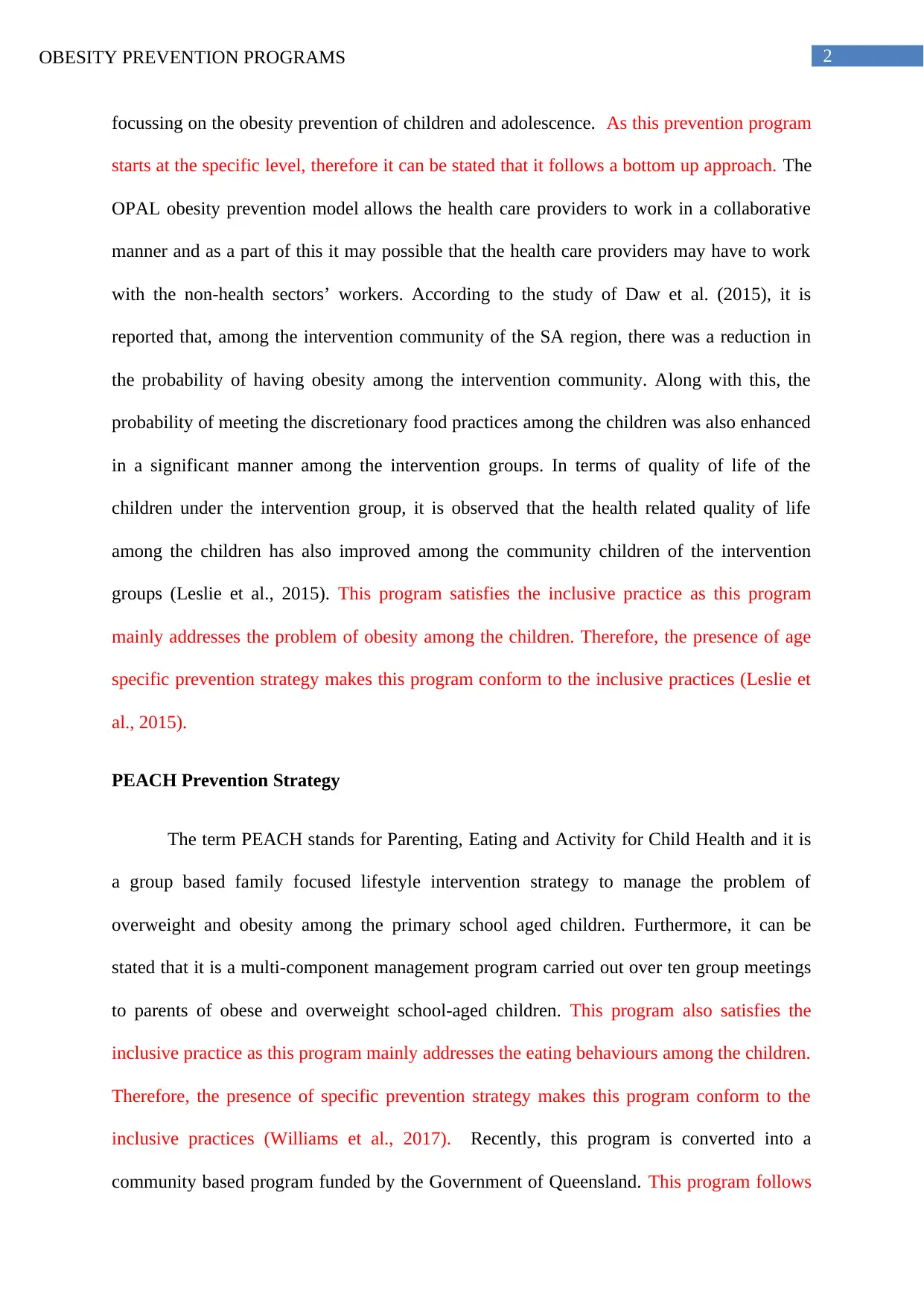
2OBESITY PREVENTION PROGRAMS
focussing on the obesity prevention of children and adolescence. As this prevention program
starts at the specific level, therefore it can be stated that it follows a bottom up approach. The
OPAL obesity prevention model allows the health care providers to work in a collaborative
manner and as a part of this it may possible that the health care providers may have to work
with the non-health sectors’ workers. According to the study of Daw et al. (2015), it is
reported that, among the intervention community of the SA region, there was a reduction in
the probability of having obesity among the intervention community. Along with this, the
probability of meeting the discretionary food practices among the children was also enhanced
in a significant manner among the intervention groups. In terms of quality of life of the
children under the intervention group, it is observed that the health related quality of life
among the children has also improved among the community children of the intervention
groups (Leslie et al., 2015). This program satisfies the inclusive practice as this program
mainly addresses the problem of obesity among the children. Therefore, the presence of age
specific prevention strategy makes this program conform to the inclusive practices (Leslie et
al., 2015).
PEACH Prevention Strategy
The term PEACH stands for Parenting, Eating and Activity for Child Health and it is
a group based family focused lifestyle intervention strategy to manage the problem of
overweight and obesity among the primary school aged children. Furthermore, it can be
stated that it is a multi-component management program carried out over ten group meetings
to parents of obese and overweight school-aged children. This program also satisfies the
inclusive practice as this program mainly addresses the eating behaviours among the children.
Therefore, the presence of specific prevention strategy makes this program conform to the
inclusive practices (Williams et al., 2017). Recently, this program is converted into a
community based program funded by the Government of Queensland. This program follows
focussing on the obesity prevention of children and adolescence. As this prevention program
starts at the specific level, therefore it can be stated that it follows a bottom up approach. The
OPAL obesity prevention model allows the health care providers to work in a collaborative
manner and as a part of this it may possible that the health care providers may have to work
with the non-health sectors’ workers. According to the study of Daw et al. (2015), it is
reported that, among the intervention community of the SA region, there was a reduction in
the probability of having obesity among the intervention community. Along with this, the
probability of meeting the discretionary food practices among the children was also enhanced
in a significant manner among the intervention groups. In terms of quality of life of the
children under the intervention group, it is observed that the health related quality of life
among the children has also improved among the community children of the intervention
groups (Leslie et al., 2015). This program satisfies the inclusive practice as this program
mainly addresses the problem of obesity among the children. Therefore, the presence of age
specific prevention strategy makes this program conform to the inclusive practices (Leslie et
al., 2015).
PEACH Prevention Strategy
The term PEACH stands for Parenting, Eating and Activity for Child Health and it is
a group based family focused lifestyle intervention strategy to manage the problem of
overweight and obesity among the primary school aged children. Furthermore, it can be
stated that it is a multi-component management program carried out over ten group meetings
to parents of obese and overweight school-aged children. This program also satisfies the
inclusive practice as this program mainly addresses the eating behaviours among the children.
Therefore, the presence of specific prevention strategy makes this program conform to the
inclusive practices (Williams et al., 2017). Recently, this program is converted into a
community based program funded by the Government of Queensland. This program follows
⊘ This is a preview!⊘
Do you want full access?
Subscribe today to unlock all pages.

Trusted by 1+ million students worldwide
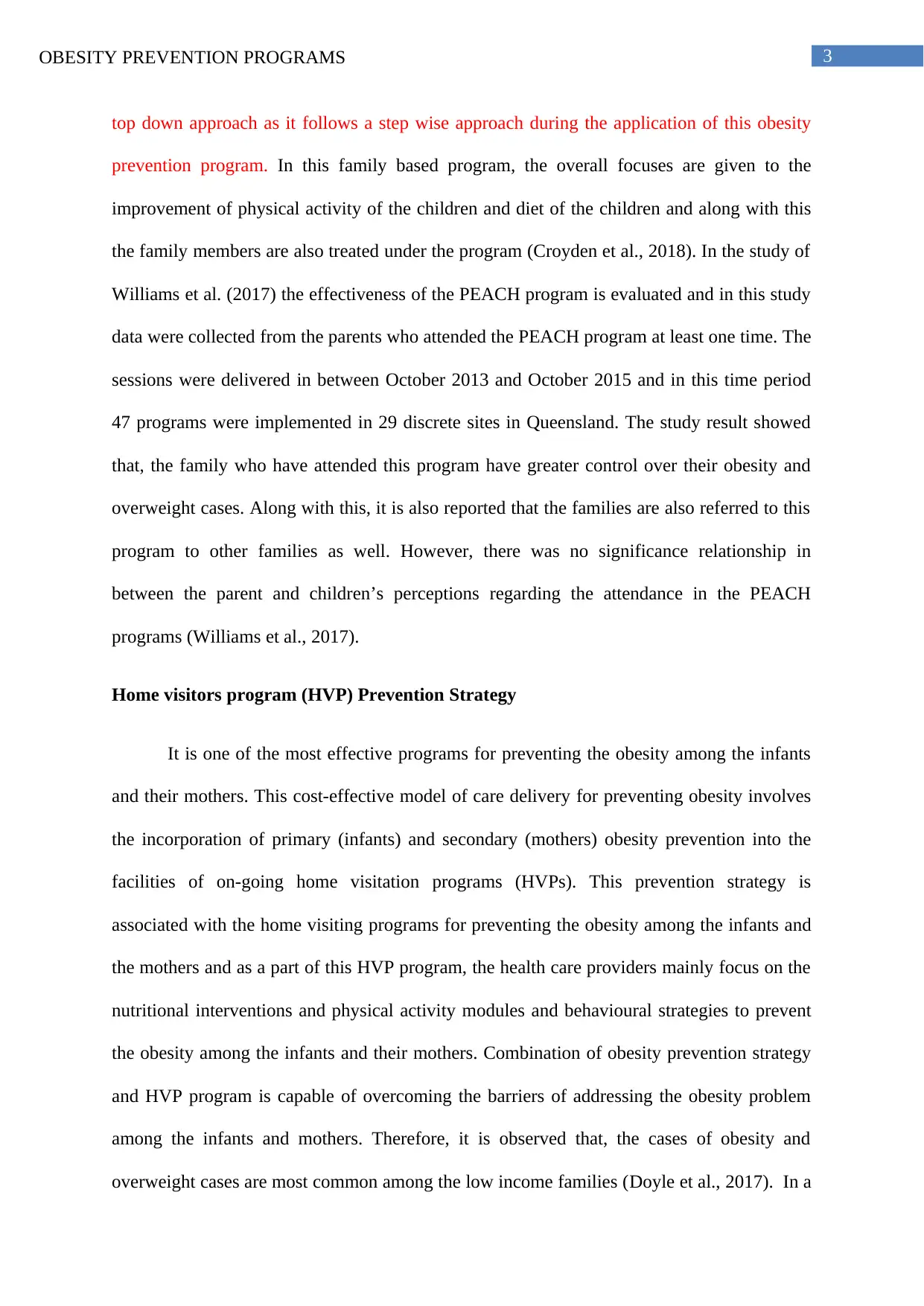
3OBESITY PREVENTION PROGRAMS
top down approach as it follows a step wise approach during the application of this obesity
prevention program. In this family based program, the overall focuses are given to the
improvement of physical activity of the children and diet of the children and along with this
the family members are also treated under the program (Croyden et al., 2018). In the study of
Williams et al. (2017) the effectiveness of the PEACH program is evaluated and in this study
data were collected from the parents who attended the PEACH program at least one time. The
sessions were delivered in between October 2013 and October 2015 and in this time period
47 programs were implemented in 29 discrete sites in Queensland. The study result showed
that, the family who have attended this program have greater control over their obesity and
overweight cases. Along with this, it is also reported that the families are also referred to this
program to other families as well. However, there was no significance relationship in
between the parent and children’s perceptions regarding the attendance in the PEACH
programs (Williams et al., 2017).
Home visitors program (HVP) Prevention Strategy
It is one of the most effective programs for preventing the obesity among the infants
and their mothers. This cost-effective model of care delivery for preventing obesity involves
the incorporation of primary (infants) and secondary (mothers) obesity prevention into the
facilities of on-going home visitation programs (HVPs). This prevention strategy is
associated with the home visiting programs for preventing the obesity among the infants and
the mothers and as a part of this HVP program, the health care providers mainly focus on the
nutritional interventions and physical activity modules and behavioural strategies to prevent
the obesity among the infants and their mothers. Combination of obesity prevention strategy
and HVP program is capable of overcoming the barriers of addressing the obesity problem
among the infants and mothers. Therefore, it is observed that, the cases of obesity and
overweight cases are most common among the low income families (Doyle et al., 2017). In a
top down approach as it follows a step wise approach during the application of this obesity
prevention program. In this family based program, the overall focuses are given to the
improvement of physical activity of the children and diet of the children and along with this
the family members are also treated under the program (Croyden et al., 2018). In the study of
Williams et al. (2017) the effectiveness of the PEACH program is evaluated and in this study
data were collected from the parents who attended the PEACH program at least one time. The
sessions were delivered in between October 2013 and October 2015 and in this time period
47 programs were implemented in 29 discrete sites in Queensland. The study result showed
that, the family who have attended this program have greater control over their obesity and
overweight cases. Along with this, it is also reported that the families are also referred to this
program to other families as well. However, there was no significance relationship in
between the parent and children’s perceptions regarding the attendance in the PEACH
programs (Williams et al., 2017).
Home visitors program (HVP) Prevention Strategy
It is one of the most effective programs for preventing the obesity among the infants
and their mothers. This cost-effective model of care delivery for preventing obesity involves
the incorporation of primary (infants) and secondary (mothers) obesity prevention into the
facilities of on-going home visitation programs (HVPs). This prevention strategy is
associated with the home visiting programs for preventing the obesity among the infants and
the mothers and as a part of this HVP program, the health care providers mainly focus on the
nutritional interventions and physical activity modules and behavioural strategies to prevent
the obesity among the infants and their mothers. Combination of obesity prevention strategy
and HVP program is capable of overcoming the barriers of addressing the obesity problem
among the infants and mothers. Therefore, it is observed that, the cases of obesity and
overweight cases are most common among the low income families (Doyle et al., 2017). In a
Paraphrase This Document
Need a fresh take? Get an instant paraphrase of this document with our AI Paraphraser
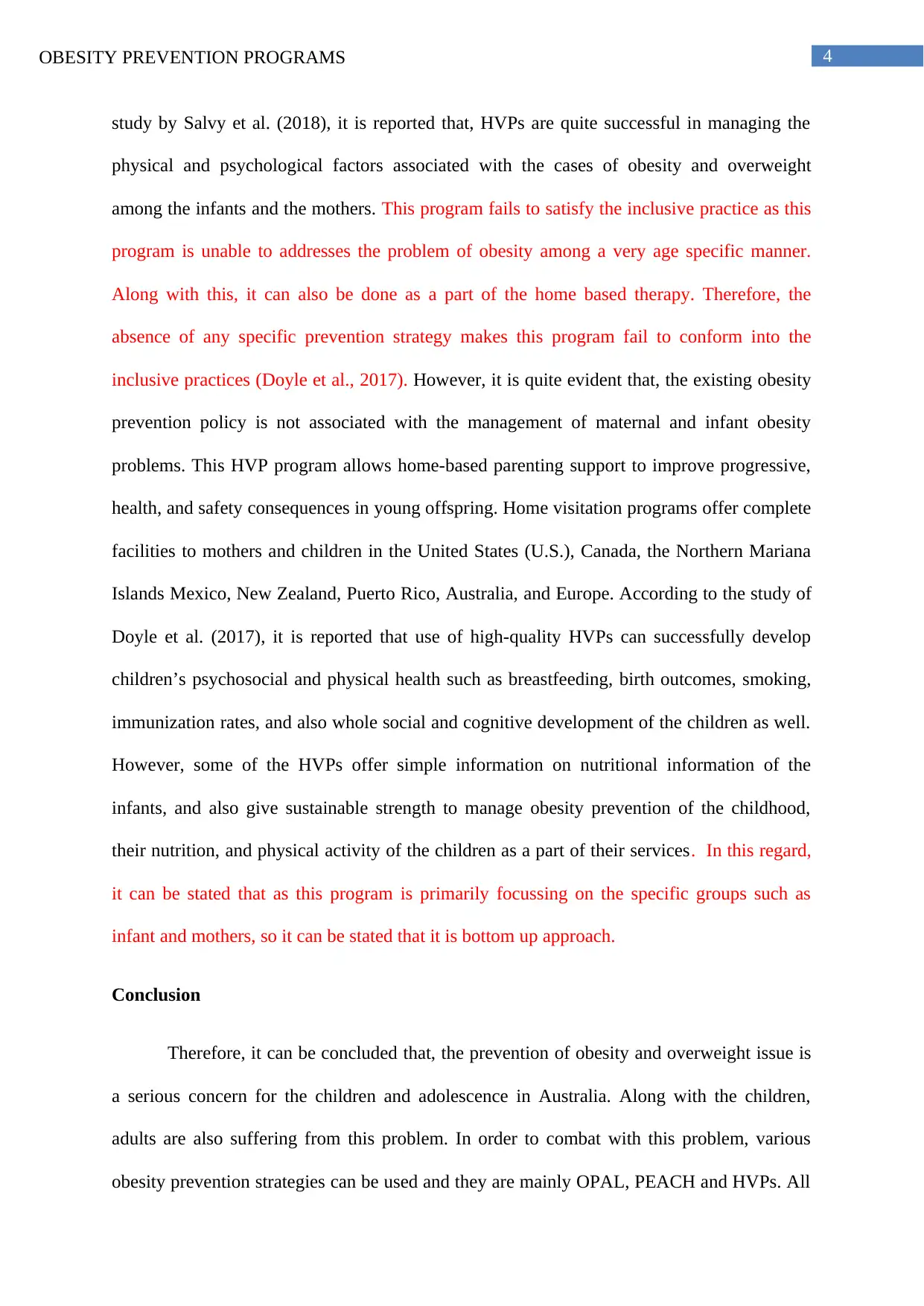
4OBESITY PREVENTION PROGRAMS
study by Salvy et al. (2018), it is reported that, HVPs are quite successful in managing the
physical and psychological factors associated with the cases of obesity and overweight
among the infants and the mothers. This program fails to satisfy the inclusive practice as this
program is unable to addresses the problem of obesity among a very age specific manner.
Along with this, it can also be done as a part of the home based therapy. Therefore, the
absence of any specific prevention strategy makes this program fail to conform into the
inclusive practices (Doyle et al., 2017). However, it is quite evident that, the existing obesity
prevention policy is not associated with the management of maternal and infant obesity
problems. This HVP program allows home-based parenting support to improve progressive,
health, and safety consequences in young offspring. Home visitation programs offer complete
facilities to mothers and children in the United States (U.S.), Canada, the Northern Mariana
Islands Mexico, New Zealand, Puerto Rico, Australia, and Europe. According to the study of
Doyle et al. (2017), it is reported that use of high-quality HVPs can successfully develop
children’s psychosocial and physical health such as breastfeeding, birth outcomes, smoking,
immunization rates, and also whole social and cognitive development of the children as well.
However, some of the HVPs offer simple information on nutritional information of the
infants, and also give sustainable strength to manage obesity prevention of the childhood,
their nutrition, and physical activity of the children as a part of their services. In this regard,
it can be stated that as this program is primarily focussing on the specific groups such as
infant and mothers, so it can be stated that it is bottom up approach.
Conclusion
Therefore, it can be concluded that, the prevention of obesity and overweight issue is
a serious concern for the children and adolescence in Australia. Along with the children,
adults are also suffering from this problem. In order to combat with this problem, various
obesity prevention strategies can be used and they are mainly OPAL, PEACH and HVPs. All
study by Salvy et al. (2018), it is reported that, HVPs are quite successful in managing the
physical and psychological factors associated with the cases of obesity and overweight
among the infants and the mothers. This program fails to satisfy the inclusive practice as this
program is unable to addresses the problem of obesity among a very age specific manner.
Along with this, it can also be done as a part of the home based therapy. Therefore, the
absence of any specific prevention strategy makes this program fail to conform into the
inclusive practices (Doyle et al., 2017). However, it is quite evident that, the existing obesity
prevention policy is not associated with the management of maternal and infant obesity
problems. This HVP program allows home-based parenting support to improve progressive,
health, and safety consequences in young offspring. Home visitation programs offer complete
facilities to mothers and children in the United States (U.S.), Canada, the Northern Mariana
Islands Mexico, New Zealand, Puerto Rico, Australia, and Europe. According to the study of
Doyle et al. (2017), it is reported that use of high-quality HVPs can successfully develop
children’s psychosocial and physical health such as breastfeeding, birth outcomes, smoking,
immunization rates, and also whole social and cognitive development of the children as well.
However, some of the HVPs offer simple information on nutritional information of the
infants, and also give sustainable strength to manage obesity prevention of the childhood,
their nutrition, and physical activity of the children as a part of their services. In this regard,
it can be stated that as this program is primarily focussing on the specific groups such as
infant and mothers, so it can be stated that it is bottom up approach.
Conclusion
Therefore, it can be concluded that, the prevention of obesity and overweight issue is
a serious concern for the children and adolescence in Australia. Along with the children,
adults are also suffering from this problem. In order to combat with this problem, various
obesity prevention strategies can be used and they are mainly OPAL, PEACH and HVPs. All
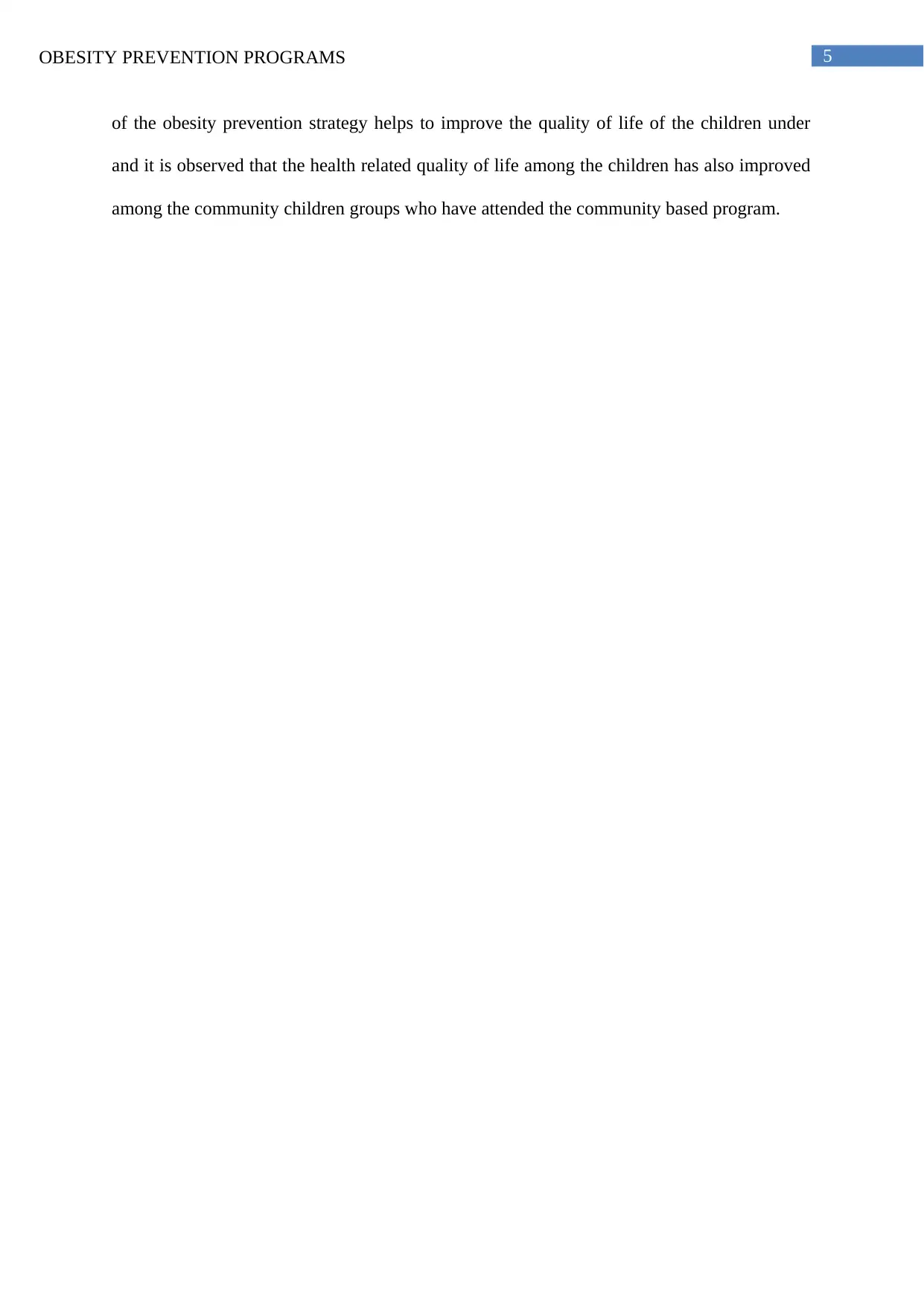
5OBESITY PREVENTION PROGRAMS
of the obesity prevention strategy helps to improve the quality of life of the children under
and it is observed that the health related quality of life among the children has also improved
among the community children groups who have attended the community based program.
of the obesity prevention strategy helps to improve the quality of life of the children under
and it is observed that the health related quality of life among the children has also improved
among the community children groups who have attended the community based program.
⊘ This is a preview!⊘
Do you want full access?
Subscribe today to unlock all pages.

Trusted by 1+ million students worldwide
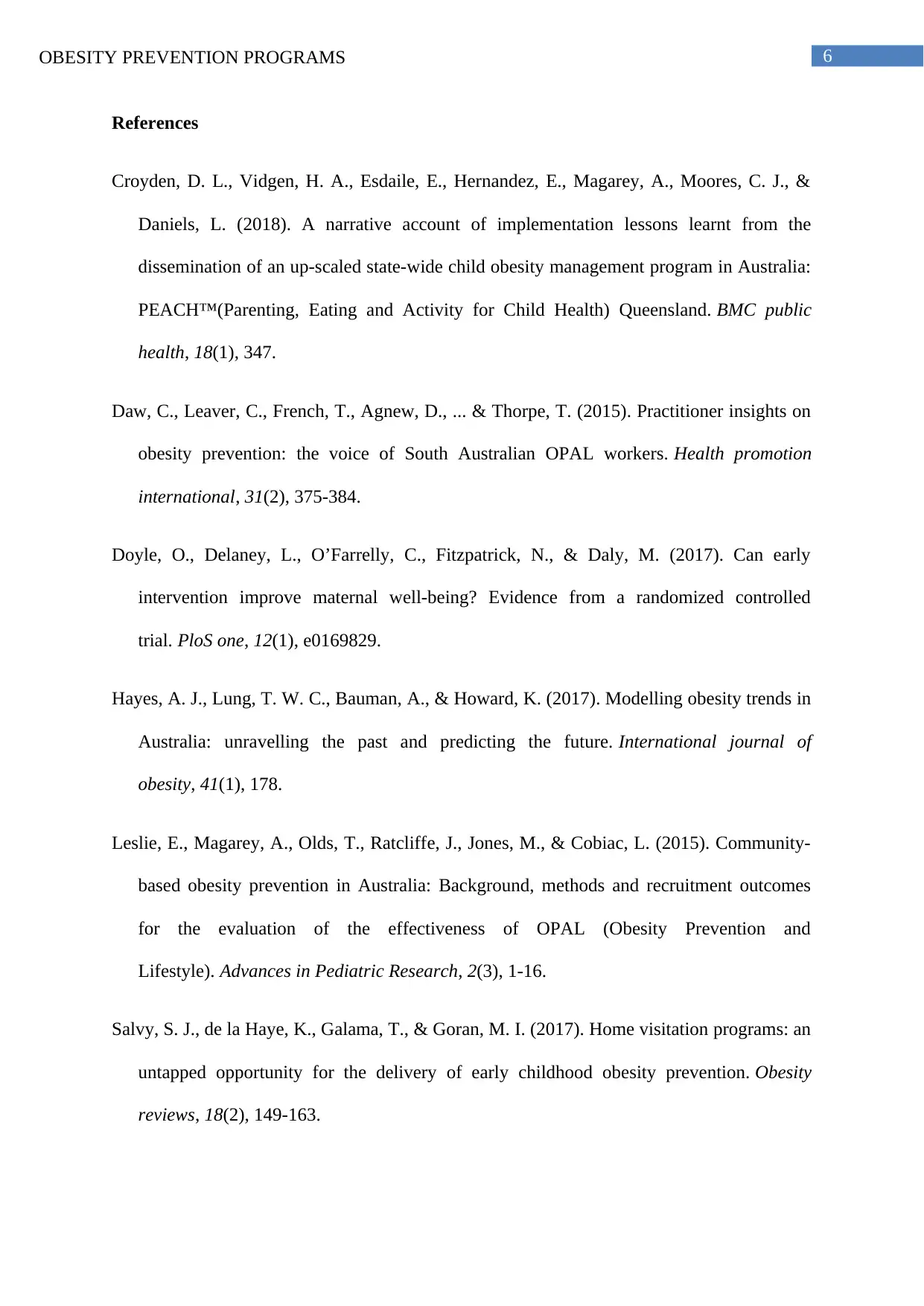
6OBESITY PREVENTION PROGRAMS
References
Croyden, D. L., Vidgen, H. A., Esdaile, E., Hernandez, E., Magarey, A., Moores, C. J., &
Daniels, L. (2018). A narrative account of implementation lessons learnt from the
dissemination of an up-scaled state-wide child obesity management program in Australia:
PEACH™(Parenting, Eating and Activity for Child Health) Queensland. BMC public
health, 18(1), 347.
Daw, C., Leaver, C., French, T., Agnew, D., ... & Thorpe, T. (2015). Practitioner insights on
obesity prevention: the voice of South Australian OPAL workers. Health promotion
international, 31(2), 375-384.
Doyle, O., Delaney, L., O’Farrelly, C., Fitzpatrick, N., & Daly, M. (2017). Can early
intervention improve maternal well-being? Evidence from a randomized controlled
trial. PloS one, 12(1), e0169829.
Hayes, A. J., Lung, T. W. C., Bauman, A., & Howard, K. (2017). Modelling obesity trends in
Australia: unravelling the past and predicting the future. International journal of
obesity, 41(1), 178.
Leslie, E., Magarey, A., Olds, T., Ratcliffe, J., Jones, M., & Cobiac, L. (2015). Community-
based obesity prevention in Australia: Background, methods and recruitment outcomes
for the evaluation of the effectiveness of OPAL (Obesity Prevention and
Lifestyle). Advances in Pediatric Research, 2(3), 1-16.
Salvy, S. J., de la Haye, K., Galama, T., & Goran, M. I. (2017). Home visitation programs: an
untapped opportunity for the delivery of early childhood obesity prevention. Obesity
reviews, 18(2), 149-163.
References
Croyden, D. L., Vidgen, H. A., Esdaile, E., Hernandez, E., Magarey, A., Moores, C. J., &
Daniels, L. (2018). A narrative account of implementation lessons learnt from the
dissemination of an up-scaled state-wide child obesity management program in Australia:
PEACH™(Parenting, Eating and Activity for Child Health) Queensland. BMC public
health, 18(1), 347.
Daw, C., Leaver, C., French, T., Agnew, D., ... & Thorpe, T. (2015). Practitioner insights on
obesity prevention: the voice of South Australian OPAL workers. Health promotion
international, 31(2), 375-384.
Doyle, O., Delaney, L., O’Farrelly, C., Fitzpatrick, N., & Daly, M. (2017). Can early
intervention improve maternal well-being? Evidence from a randomized controlled
trial. PloS one, 12(1), e0169829.
Hayes, A. J., Lung, T. W. C., Bauman, A., & Howard, K. (2017). Modelling obesity trends in
Australia: unravelling the past and predicting the future. International journal of
obesity, 41(1), 178.
Leslie, E., Magarey, A., Olds, T., Ratcliffe, J., Jones, M., & Cobiac, L. (2015). Community-
based obesity prevention in Australia: Background, methods and recruitment outcomes
for the evaluation of the effectiveness of OPAL (Obesity Prevention and
Lifestyle). Advances in Pediatric Research, 2(3), 1-16.
Salvy, S. J., de la Haye, K., Galama, T., & Goran, M. I. (2017). Home visitation programs: an
untapped opportunity for the delivery of early childhood obesity prevention. Obesity
reviews, 18(2), 149-163.
Paraphrase This Document
Need a fresh take? Get an instant paraphrase of this document with our AI Paraphraser
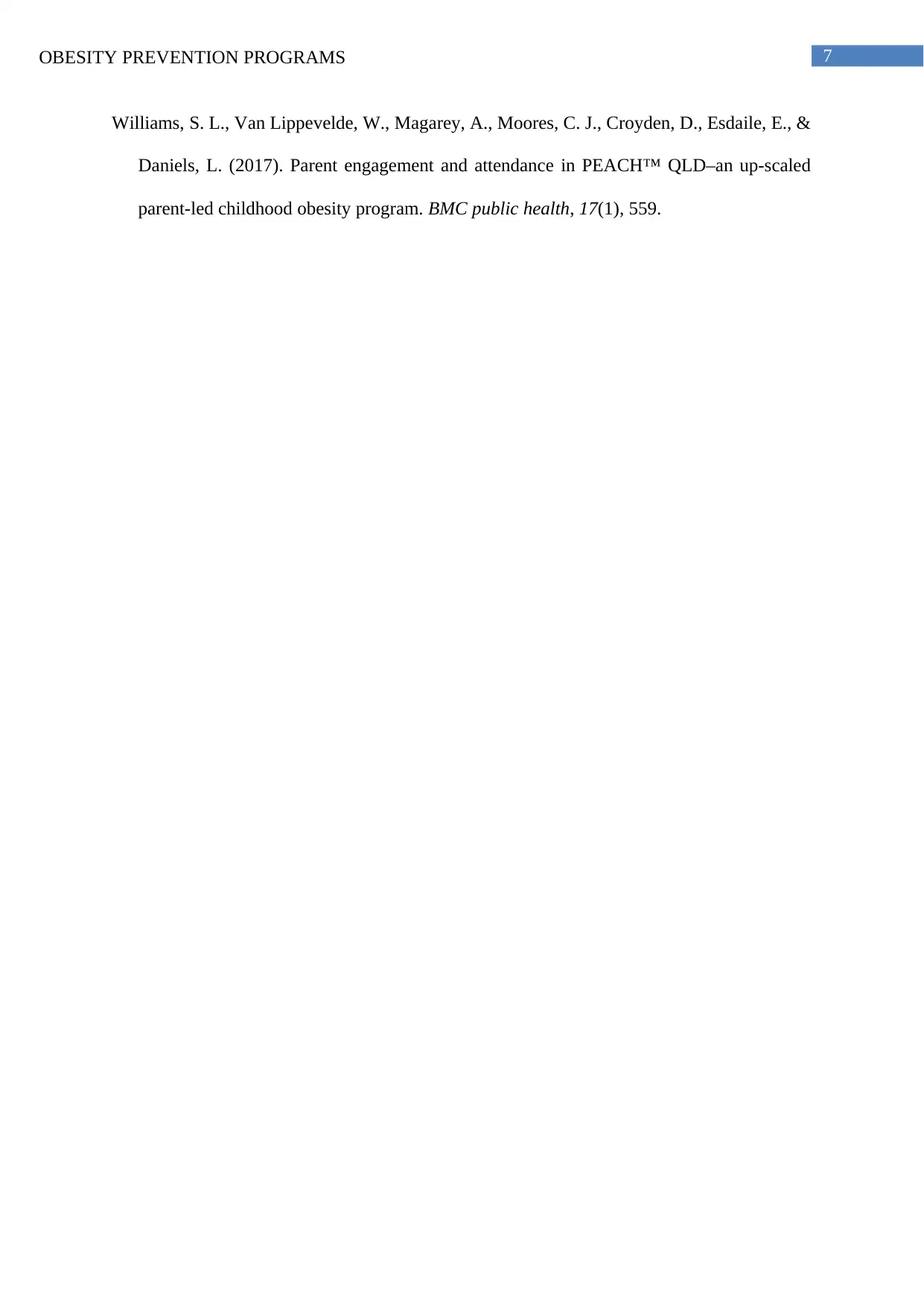
7OBESITY PREVENTION PROGRAMS
Williams, S. L., Van Lippevelde, W., Magarey, A., Moores, C. J., Croyden, D., Esdaile, E., &
Daniels, L. (2017). Parent engagement and attendance in PEACH™ QLD–an up-scaled
parent-led childhood obesity program. BMC public health, 17(1), 559.
Williams, S. L., Van Lippevelde, W., Magarey, A., Moores, C. J., Croyden, D., Esdaile, E., &
Daniels, L. (2017). Parent engagement and attendance in PEACH™ QLD–an up-scaled
parent-led childhood obesity program. BMC public health, 17(1), 559.

8OBESITY PREVENTION PROGRAMS
⊘ This is a preview!⊘
Do you want full access?
Subscribe today to unlock all pages.

Trusted by 1+ million students worldwide

9OBESITY PREVENTION PROGRAMS
1 out of 10
Related Documents
Your All-in-One AI-Powered Toolkit for Academic Success.
+13062052269
info@desklib.com
Available 24*7 on WhatsApp / Email
![[object Object]](/_next/static/media/star-bottom.7253800d.svg)
Unlock your academic potential
Copyright © 2020–2025 A2Z Services. All Rights Reserved. Developed and managed by ZUCOL.





